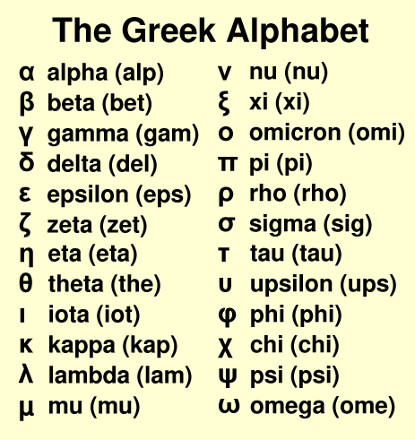
by John P. Pratt
9 Dec 2018, 13 Flower (SR), α Vir (US)
©2018 by John P. Pratt. All rights Reserved.
| 1. Tied to U. Enoch Calendar |
| 2. Fixed Holy Days |
| 2.1 Bright Stars |
| 2.2 Dragon Stars |
| 2.3 Lunar Mansions |
| 2.4 Begin Zodiac Months |
| 2.5 Constellation Reps |
| 3. Seasonal Holy Days |
| 4. U. Star Calendar Results |
| 5. Conclusion |
| Notes |
The Book of Enoch describes a star calendar with 364 days, each represented by a star, which in turn represents a servant of God. Earlier articles introduced the Star Calendar (S) based on that book, laying the groundwork that the year is divided into twelve zodiac "months",[1] identifying all of the stars,[2] and placing the stars in order.[3] This article identifies the holy days on the uniform version of that calendar, called the Uniform Star Calendar (US).
The Uniform Star Calendar has exactly 364 days in every year. Because it never has leap years, it does not track the actual position of the stars in the heavens. The Uniform Enoch Calendar (UE) likewise always has 364 days. Thus, these two calendars are forever linked together such that any given US calendar day always falls on the same UE day.
The UE Calendar year is divided into four seasons, even though they do not correspond to actual seasons. The US Calendar has the month of Leo begin on the same day as 1 Summer (UE) and has the month of Aquarius begin six zodiac months later on 1 Winter (UE). Thus, the Uniform Star Calendar also has "seasons" defined by the UE Calendar. That is, 1 Leo begins Summer and 1 Aqr begins Winter (US). Then three zodiac months after each, 1 Sco begins Autumn and 1 Tau begins Spring (US).
This article presents holy days based on the stars which apply to both versions of the Star Calendars. It also presents "seasonal" holy days, which correspond to the feast days on the Enoch and Hebrew calendars. They are only given in detail for the US Calendar because they are tied to the UE. That is, the US seasons do not precess through different zodiac months. On the other hand, the Star Calendar (S) does indeed track the actual positions of the heavens, including their slow precession through the seasons of 1° every 72 years.[4] Thus, its seasonal holy days actually change constellations. They will be covered in a future article.
 |
There are fifteen of the brightest stars which are major holy days on both star calendars. They fall on sixteen days because one of those stars is in two constellations and has one day for each. There are five bright stars in the "heavens", which refers to the area northward in the sky from the twelve zodiac constellations. There are seven on "earth", referring to the zodiac figures, and four more in the "underworld", south of the zodiac (see Table 2).
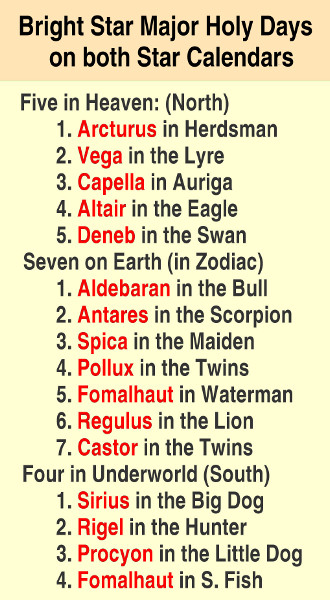 |
There are 28 stars spaced approximately evenly throughout the year which are called "lunar mansions" or "lunar stations". They have been honored since ancient Babylon as markers of the daily progress of the moon through the stars each month.
As this work proceeded it became clear that these stars were considered as at least minor holy days by the Lord because sacred events often happened on those star days. Thus, an attempt was made to correctly identify all of those stars.
It was also noticed that in the Book of Revelation in the New Testament, John the Revelator declares that he saw 24 seats for 24 elders around the throne of God (Rev. 4:5). He also saw four beasts likewise surrounding the throne. The four beasts correspond to the four cornerstone constellations of the Lion, Scorpion (or Eagle, see Ezek 10:1), Bull, and Waterman. Each of those four contain a bright "royal" star, each of which is one of the 28 lunar mansions. Those lunar mansions form a circle centered on the center point in the heavens symbolizing the throne of God. That leaves 24 other lunar mansions in the zodiac circle. In an earlier article[6] it was proposed that those 24 might well correspond to the 24 seats around the throne of God, which would explain why they are considered to be holy days!
Another point is that the Book of Enoch states that in addition to the four royal stars, there are 12 captains of thirty for the total of 364 stars. Those captains sound like the first days of each zodiac month, even though they do not have thirty days each. If so, then the question arose whether or not the 12 lead stars of each zodiac month may also be lunar mansions. If so, it would mean that the same man would need to sit both in a seat of one of the 24 elders and also in the seat of a captain. When this question was further researched, it was decided that none of the captains may coincide with any of the lunar mansions. Adjustments have been made in the proposed lunar mansion list and the result in every case is much more evenly spaced lunar mansions, which is their purpose.
Thus, in both the Star Calendar and Uniform Star Calendar, these 28 stars are on holy days, as are the 15 bright stars and 12 Dragon stars.
On the Enoch and Hebrew calendars, the first day of each month is a holy day, with the first of each of the four seasons being a major holy day. It is the same on both star calendars.
In the case of the Uniform Star Calendar (US), the "seasons" never change, so it is first day of the months of the Lion (summer), Scorpion (autumn), Waterman (winter) and Bull (spring) which are major holy days, with the others being minor holy days.
In the case of the Star Calendar which precesses slowly through the seasons, the season starting days vary as will be discussed in a future article.
There are many important smaller constellations which need to have at least one representative star to be a holy day. This list is not yet firmly established, but a tentative list has been proposed, which includes at least one star as a minor holy day representing each of the forty constellations included in the 364-day year. They are shown in the results section of this article.
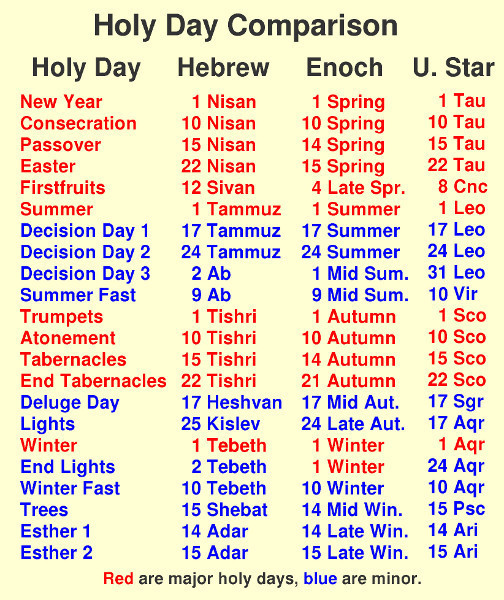 |
For example, both the Enoch and Hebrew Calendars have feast days such as Passover, Firstfruits, Trumpets, Tabernacles and the Festival of Lights. They fall on specified days of given months. For example, on the Hebrew Calendar, Passover falls on day 15 of the first month in spring and Tabernacles on day 15 of the seventh month in autumn.
It is exactly the same with the star calendars! There is a "Passover" major holy day on day 15 of the first month of spring and Tabernacles on day 15 of the seventh month in Autumn. In the case of the Uniform Star Calendar, the spring month is always the Bull (Taurus) and the autumn month is always the Scorpion (Scorpius). Table 3 shows the corresponding day for all of the Hebrew and Enoch holy days on the Uniform Star Calendar. The correspondence on the Star Calendar will be given in a future article.
The resulting holy days for the Uniform Star Calendar are given in the following four tables, arranged by Uniform Enoch (UE) Calendar seasons. Because the UE Calendar and US Calendar both always have exactly 364 days, they are always synchronized the same way, so that these illustrations constitute a perpetual calendar. 1 Summer (UE) always falls on 1 Leo (US) and 1 Winter (UE) is always on 1 Aqr (US) six months later. The day numbers of the months of the UE Calendar are printed in large dim numbers in each box. That calendar is very simple, having three months of 30 days each season, ending on a "0" day of the next season being either an equinox or solstice day. Major UE holy days are in light red and minor are in light blue.
The first day of each zodiac month begins on a Saturday at noon. Because we are used to a weekly calendar beginning each week on a Sunday, it was decided to ask the reader to remember that when the first day of each month is shown as Sunday, that it is really only Sunday morning that is implied. That first day also includes the previous Saturday afternoon.[7]
In the four calendar tables, there are up to three entries in each day box. The first is the day of the month, such a 1 Leo, 2 Leo, etc., simply numbered sequentially. In some months, two constellations overlap, such as Capricornus and Aquarius. In those cases, each day belongs to only one of those months (zodiac constellations), numbered from the first day of that month.
The seasonal holy days, such as Passover, have the holy days shown on that first entry in the box so the numbered day of the month is implied rather than shown. That is, Passover is always day 15 of the spring month, which is always Taurus in the case of the Uniform Star Calendar. It is important to understand that the seasonal days depend only on the day of the month and not on the particular star associated with that day.
Major seasonal holy days have the day (first entry in box) printed in red, with minor holy days in blue. The star information (next two lines) is printed in orange for bright stars, red for Dragon stars, green for lunar mansions, blue for other minor holy day stars (including constellation reps), and black for other stars. The first of those entries on the middle line is the astronomical designation of the star, being a Greek letter with the abbreviation of the constellation, such a β Leo. The last entry in each box is the English name proposed in my work for the star.
Months with fewer days than required for a given holy day are special cases. For example, the Festival of Lights falls on 25 Kislev (9th month) on the Hebrew Calendar and 24 Late Autumn (9th month) on the Enoch Calendar (see Table 3). The ninth month counting from spring on the US Calendar is Capricorn, which only has 21 days, being only 3 weeks long. Still the Festival of Lights falls on the 24th day (like the Enoch Calendar) counting from 1 Cap. That falls on 17 Aquarius. So that is when "Lights" is celebrated (US). Similarly, Firstfruits is always 7 weeks after Easter Sunday.
Easter Sunday is another case worth mentioning. On the Enoch Calendar, Passover is Sat 14 Spring. Easter is always the Sunday after Passover, so it falls on Sun 15 Spring. But the star calendars are more like the Hebrew. Passover is always day 15 of the first month of spring, which is always includes Sunday morning. Thus, Easter must fall a full week after Passover on day 22. That is the same as when Passover falls on a Sunday on the Hebrew Calendar.
Another important point is that Passover on the Star Calendars is on the first day number 15 of a month that falls on or after the spring equinox. In the case of the Star Calendar, that first month of spring precesses from Gemini at the time of Adam to Aquarius in the Millennium. Details of just how and when that shift of the Passover month happens will be discussed in a future article. In the case of the Uniform Star Calendar, however, that relationship is fixed always to be in the same month. In the last chart (spring), it is seen that the first day numbered 15 after the spring equinox (21 Ari, the last day of the previous quarter) is 15 Tau (α Tau, Alebaran, Seer, one of the four bright royal stars). Thus, Passover always falls on 15 Tau on the US Calendar.
 |
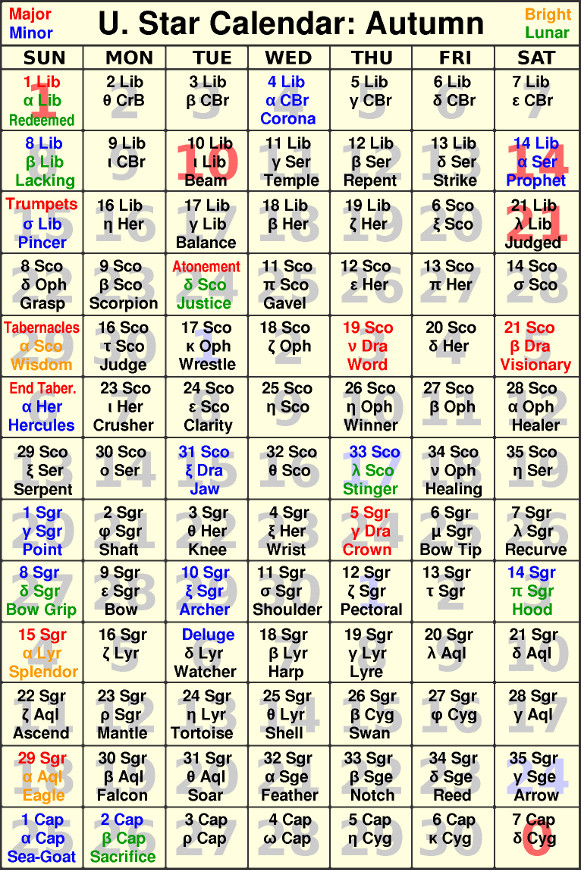 |
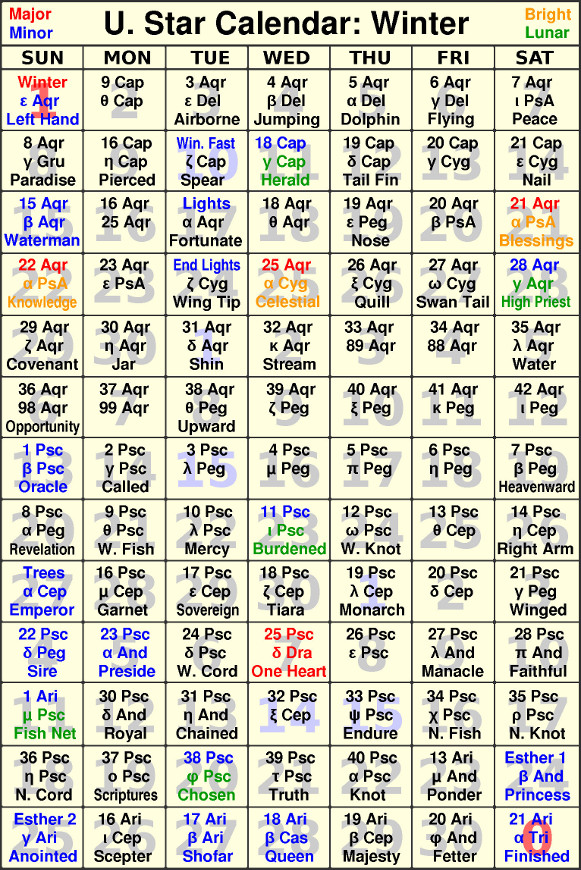 |
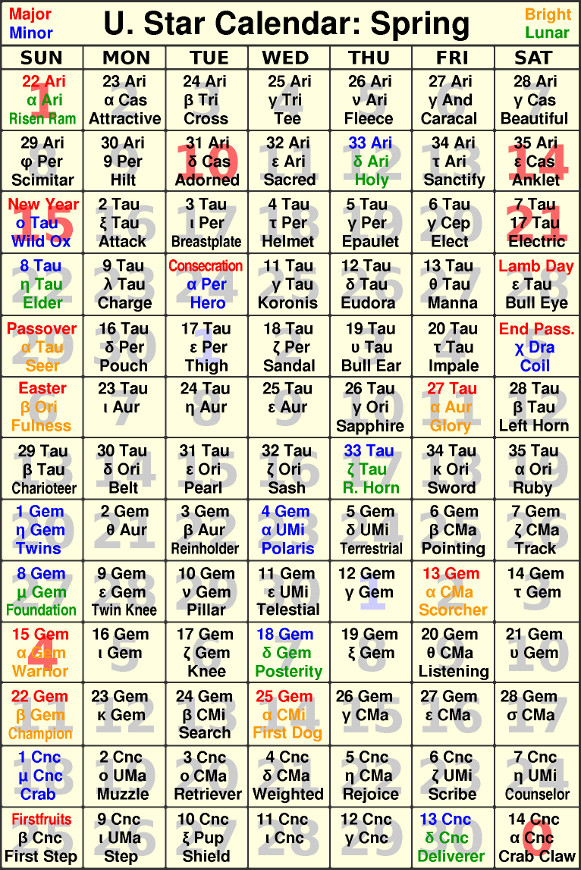 |
Altogether, this adds up to 91 holy days out of 364, or one day in four being a holy day! Most calendars have about one day in seven being holy, with only about 10 major holy days per year. The Star Calendars have about 30 major holy days. That large number is because they have all of the holy days of the Hebrew and Enoch calendars as well as all of those based on the stars themselves.
The holy days of the Star Calendar and Uniform Star Calendar are presented. There are holy days for bright stars, stars in the Dragon constellation, lunar mansions, the first day of each zodiac month, at least one representative star from each constellation, and days corresponding to holy days on the Hebrew and Enoch calendars. Four seasonal tables of these holy days are presented for the case of the Uniform Star Calendar, in which the seasons do not precess. The magnificence and order of these Star Calendars is a compelling witness of that indeed all things in the heavens testify of Jesus Christ (Moses 6:63)!